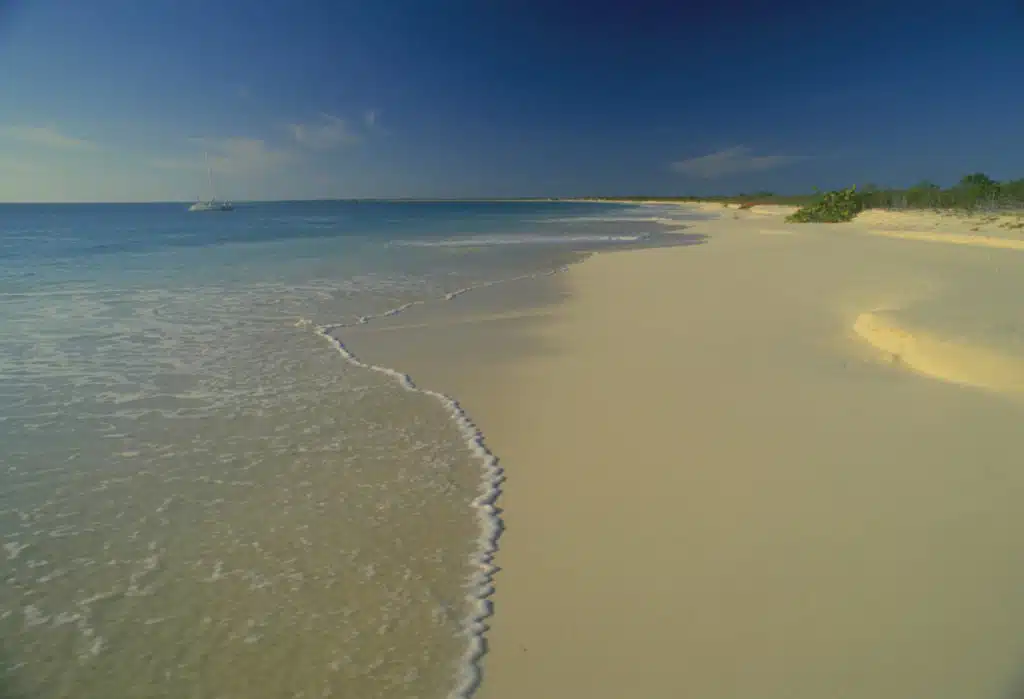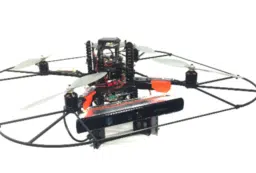Certain small reef fish use wing-like fins to ‘fly’ underwater, allowing them to cruise at speeds equivalent to tuna, a team of Australian and US researchers has found. The design of the fins has drawn the attention of underwater submersible designers and the US Office of Naval Research.
The wing-like fins, discovered by researchers from the ARC Centre of Excellence for Coral Reef Studies, allow these fish to handle strong water currents with ease. And the research team has also found that if these specialised fish are lost to overfishing, reefs worldwide would suffer.
“Some species of parrotfish, wrasse and surgeonfish have developed wing-like fins which they move in a flapping motion, just like a bird,” says Dr Chris Fulton, a lecturer in the School of Botany and Zoology at The Australian National University. “This allows them to generate high swimming speeds with relatively little energy so they can move easily around their turbulent, wave-swept habitats.
“Reef fish just 10 cm long can cruise all day at an average speed of 3.6 km per hour, which is the equivalent of a typical person swimming at more than 60 km per hour.
“We were surveying fish populations on the Great Barrier Reef in 2000 and realised some of them had these unusual, wing-like fins. When we looked on coral reefs in Tahiti, PNG, and the Caribbean, we found more of the ‘winged’ fishes. On coral reefs all around the world, there are fishes that have evolved the same answer to survival in wave-swept habitats – it’s a beautiful piece of convergent evolution in action.”
Measuring the speed of the fish in a flow tank and while swimming naturally around the reef, Chris found some species could move at up to 10 body lengths per second. By comparison, Olympic champions reach speeds of just 1.3 body lengths per second, and then only for the brief 22 seconds of the 50-metre freestyle sprint.
Most reef fish have paddle-shaped fins, which they move in a rowing action: a backward power stroke to create thrust, followed by a forward recovery stroke. But thrust is only produced on half the fin strokes – limiting these fish to slow swimming speeds.
“We discovered that the fastest reef fishes have tapered fins, which they tend to flap in a figure-of-eight sweep that creates thrust on every stroke. This flapping motion creates lift forces from water flowing over the fin, just as with air moving over the wing of a bird,” Chris explains.
These underwater fliers have been very successful and colonised coral reef habitats all around the world. “Reefs can be challenging places for a fish. The crashing waves create flow speeds that are equivalent to us experiencing cyclone-force winds on land.”
“Some of these fish play a crucial role in maintaining the health of our reefs by eating the fleshy algae that would otherwise overgrow and smother live corals,” Fulton says. “But they’re at risk. In many areas of the Pacific we are seeing these specialised shallow-living fish disappear due to overfishing. If these specialised swimmers go, they won’t be replaced by slower, deeper living fish. So it is important to plan our marine reserves to protect them.”
The study was published recently in the prestigious UK journal Proceedings of the Royal Society.
Now Chris and his collaborators David Bellwood from James Cook University and Peter Wainwright from the University of California, Davis are investigating how and when the fish ‘wings’ evolved.
Their work has taken the interest of the US Office of Naval Research, and may influence the design of future remote control submersibles.
“While we are seeing rapid advancements in submersible design, such as the multi-finned Madeleine recently developed by Vassar College, we are yet to match the speed and efficiency achieved by these wing-finned coral reef fishes,” Dr Fulton says. “We still have much to learn from over 50 million years of reef fish evolution.”
Chris Fulton is one of 16 early-career scientists chosen for Fresh Science, a national program sponsored by the Federal and Victorian governments. He is presenting his research to the public for the first time at the Melbourne Museum.
Background
Swimming in the surf: reef fish match up to cyclone-force water currents
Abstract from Proceedings of the Royal Society London: B Volume 272, pages 827-832
Wave energy and swimming performance shape coral reef fish assemblages
C. J. Fulton1*, D. R. Bellwood1 and P. C. Wainwright2
1Centre for Coral Reef Biodiversity, Department of Marine Biology, James Cook University, Townsville, Queensland 4811, Australia
2Section of Evolution and Ecology, University of California, One Shields Avenue, Davis, CA 95616, USA
*Present address: School of Botany and Zoology, The Australian National University, Canberra, ACT 0200, Australia e-mail: christopher.fulton@anu.edu.au
Physical factors often have an overriding influence on the distribution patterns of organisms, and can ultimately shape the long-term structure of communities. Although distribution patterns in sessile marine organisms have frequently been attributed to functional characteristics interacting with wave-induced water motion, similar evidence for mobile organisms is lacking. Links between fin morphology and swimming performance were examined in three diverse coral reef fish families from two major evolutionary lineages. Among-habitat variation in morphology and performance was directly compared with quantitative values of wave-induced water motion from seven coral reef habitats of different depth and wave exposure on the Great Barrier Reef. Fin morphology was strongly correlated with both field and experimental swimming speeds in all three families. The range of observed swimming speeds coincided closely with the magnitude of water velocities commonly found on coral reefs. Distribution patterns in all three families displayed highly congruent relationships between fin morphology and wave-induced water motion. Our findings indicate a general functional relationship between fin morphology and swimming performance in pectoral-swimming fishes, and provide quantitative evidence that wave energy may directly influence the assemblage structure of coral reef fishes through interactions with morphology and swimming performance.
Fast and nimble coral reef fishes
Abstract from Coral Reefs Volume 26, pages 217-228
Swimming speed performance in coral reef fishes: field validations reveal distinct functional groups.
C. J. Fulton
ARC Centre of Excellence for Coral Reef Studies, James Cook University, Townsville, QLD 4811, Australia
Present Address: School of Botany and Zoology, The Australian National University, Canberra, ACT 0200, Australia e-mail: christopher.fulton@anu.edu.au
Central to our understanding of locomotion in fishes are the performance implications of using different modes of swimming. Employing a unique combination of laboratory performance trials and field observations of swimming speed, this study investigated the comparative performance of pectoral and body-caudal fin swimming within an entire assemblage of coral reef fishes (117 species 10 families). Field observations of swimming behaviour identified three primary modes: labriform (pectoral-swimming, 70 species), subcarangiform (body-caudal, 29 spp.) and chaetodontiform (augmented body-caudal, 18 spp.). While representative species from all three modes were capable of speeds exceeding 50 cm s-1 during laboratory trials, only pectoral-swimmers maintained such high speeds under field conditions. Direct comparisons revealed that pectoral-swimming species maintained field speeds at a remarkable 70% of their maximum (lab-tested) recorded speed; species using body-caudal fin propulsion maintained field speeds at around 50% of maximum. These findings highlight a profound influence of swimming mode on performance, with the relative mechanical and energetic efficiency of each swimming mode being of major importance. Combining attributes of efficiency, maneuverability and speed in one mode of propulsion, pectoral swimming appears to be a particularly versatile form of locomotion, well suited to a demersal lifestyle on coral reefs.
Winged fins for submersibles
Westneat, M. W. and J. A. Walker (2001) Pectoral fin design and swimming performance: testing thrust and efficiency models with the structure and behavior of living fishes. Proceedings of the Conference on Unmanned, Untethered Submersible Technology. Autonomous Underwater Systems Institute, Durham, N. H.
“The high efficiency and performance of the labriform mode of locomotion in fishes suggests that it would be a useful mode of propulsion for autonomous underwater vehicles.
Several design features of the coral reef fish fin mechanisms might be usefully incorporated into vehicle propulsors. Fin shape is a key determinant of propulsive efficiency, a result made clear from both hydrodynamic simulations and measurements of living animals.
Incorporation of these fin designs into AUVs may allow both high efficiency during cruising in nearshore aquatic habitats and high thrust for maneuverability in surge zones or complex three-dimensional environments. Control mechanisms that can mimic the diversity of motions in the fin stroke of a large coral reef fish would also provide an AUV with an impressive level of control. Continuing research on neural control of the pectoral fin in coral reef fishes may provide guidance control programs that can create biomimicry of such complex fin motions.”





 Fresh Science is on hold for 2022. We will be back in 2023.
Fresh Science is on hold for 2022. We will be back in 2023.